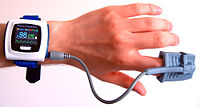
Photo from wikipedia
Aims Patients with congenital heart disease (CHD) are at increased risk for intracardiac device malfunction and infection that may necessitate extraction; however, the risk of extraction is poorly understood. This… Click to show full abstract
Aims Patients with congenital heart disease (CHD) are at increased risk for intracardiac device malfunction and infection that may necessitate extraction; however, the risk of extraction is poorly understood. This study addresses the safety of extraction in patients with structural heart disease and previous cardiac surgery. Methods and results This retrospective study included 40 CHD and 80 matched control patients, who underwent transvenous lead extractions between 2001 and 2014. Only leads >12 months were included. There were 77 leads in CHD patients and 146 in controls. The mean age was 38 ± 16 years in CHD patients. Ninety per cent of CHD patients had ≥1 cardiac surgeries when compared with 21% of controls (P < 0.001). The number of abandoned leads was significantly different (17 vs. 3, P < 0.001). Lead age was similar with an average duration of 83 ± 87 months in CHD patients and 62 ± 65 months in controls (P = 0.24). There was no significant difference in extraction techniques. Manual traction was successful in 40% of CHD patients and 47% of controls, and advanced techniques were used in 60 and 53% of CHD patients and controls, respectively. Complete extraction was achieved in 94% of the patients in both groups. There was no significant difference in complications. Conclusion Lead extraction can be safely performed in patients with CHD. Despite anatomic abnormalities and longer implantation times, the difficulty of lead extraction in patients with CHD is comparable with controls.
Journal Title: Europace
Year Published: 2017
Link to full text (if available)
Share on Social Media: Sign Up to like & get
recommendations!